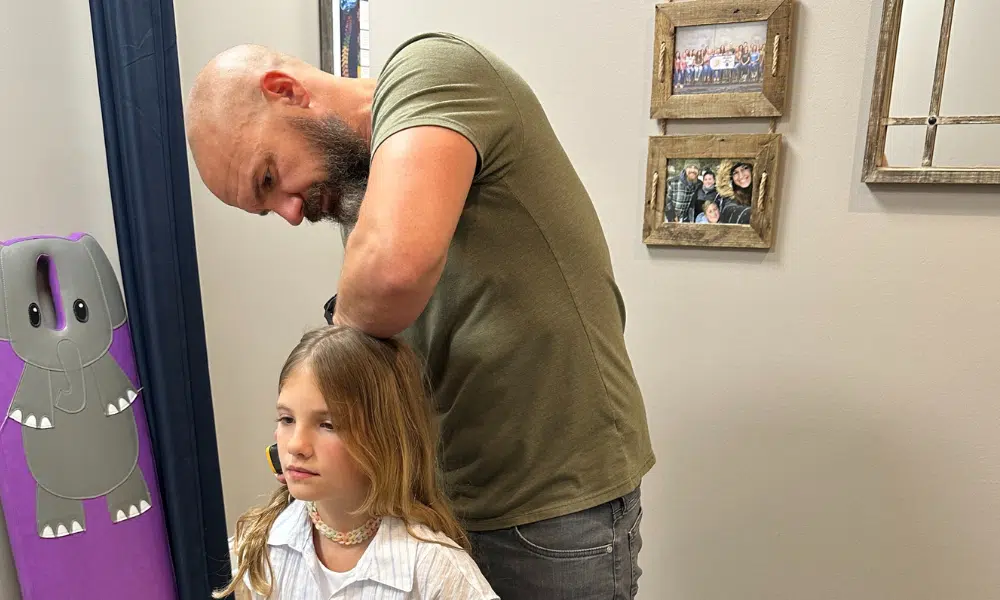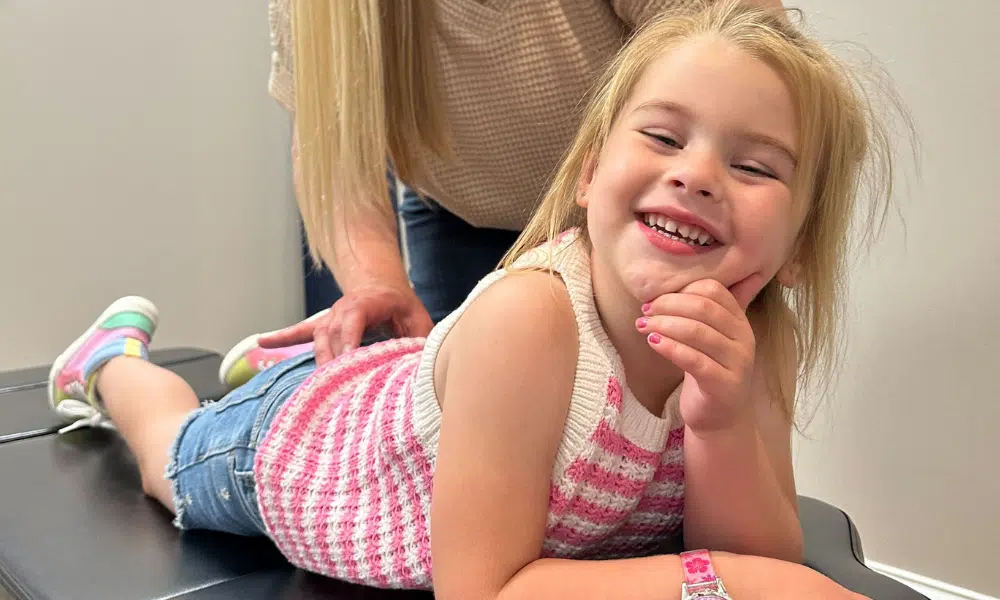As a parent, you want your child to thrive and reach their full potential. You celebrate every milestone, from their first steps to their first words, knowing that these moments lay the foundation for their future success. But what happens when your child struggles with basic movements or their development doesn’t match their peers?
Motor control issues affect many children, impacting their ability to perform everyday tasks and hindering their overall development. According to the Cleveland Clinic, as much as 6% of school-aged children have dyspraxia, a condition that can cause problems with motor control.
At the heart of gross motor skills lies the nervous system, a complex network that coordinates every movement and action. When this delicate system is thrown off balance, it can lead to a wide range of motor control difficulties. This is where PX Docs comes in, offering a unique, neurologically-focused approach to pediatric chiropractic care that aims to restore balance and unlock your child’s true potential.
In this article, we’ll explore motor control’s importance in child development, the role of the nervous system, and how PX Docs’ innovative approach can help children overcome challenges and thrive. For so many parents they’ve already pursued months if not even years of physical therapy and occupational therapy to help their children’s motor control challenges, but have reached a plateau or just simply wonder if more can be done to address the root foundational cause. If that sounds like your family, then this article is especially for you.
What is Motor Control?
Motor control is the process of initiating, directing, and grading purposeful voluntary movement. It is the ability to regulate and coordinate the body’s movements to achieve a desired action or task. This complex process involves precisely coordinating multiple systems, including skeletal muscles, bones, and nerves.
Every movement we make, from reaching for a toy to running across a playground, relies on the intricate interplay of these systems. Skeletal muscles provide the strength and power behind each motion, while bones are the structural framework to which these muscles attach. Nerves, the body’s “messengers,” transmit signals from the brain to the muscles, instructing them when and how to move.
Even before these motor output nerves can fire and coordinate their actions, a specific type of nerves called sensorimotor nerves need to first provide input and information into the brain and nervous system as to what’s going on and where they are in space. So often the most easily overlooked root cause of motor control issues is on the “input” or sensory side of things, not just the output and motor side of this intricate bodily function.
Proper motor control and proprioception are essential for children to engage in daily activities and explore the world around them. It enables them to crawl, walk, run, jump, and manipulate objects with ease and precision. As children grow and develop, their motor control skills become increasingly refined, allowing them to take on more complex tasks and challenges.
Beyond its role in physical movement, the stages of motor control also play a crucial role in a child’s overall development. It lays the foundation for cognitive, social, and emotional growth, as children learn through movement and interaction with their environment. Delays or difficulties in motor control can have far-reaching consequences, impacting a child’s ability to learn, play, and communicate effectively.
Given the paramount importance of motor control in child development, it is essential for parents and caregivers to understand the factors that influence its development and to recognize potential issues early on. By addressing motor control challenges proactively, we can help children unlock their full potential and set them on a path to lifelong success.
The Nervous System: The Key to Motor Learning and Control
At the heart of motor learning and control lies the nervous system, a complex network of cells and fibers that transmit signals throughout the body. This intricate system is responsible for processing sensory information, generating motor commands, and coordinating the body’s responses to both internal and external stimuli.
The central nervous system, which consists of the brain and spinal cord, plays a pivotal role in motor control. The brain acts as the command center, receiving sensory input from the body and environment, interpreting this information, and generating appropriate motor commands. These commands are then transmitted through the spinal cord and peripheral nerves to the muscles, directing them to contract or relax in a coordinated manner.
Within the nervous system, the Autonomic Nervous System (ANS) plays a crucial role in regulating involuntary functions, including those related to motor control. The ANS is divided into two branches:
- The sympathetic nervous system, often called the “fight or flight” response, prepares the body to react to stressful or dangerous situations. It increases heart rate, dilates pupils, and redirects blood flow to the muscles, enhancing alertness and readiness for action.
- The parasympathetic nervous system, known as the “rest, regulate, and digest” response, promotes relaxation, recovery, and restoration. It slows heart rate, constricts pupils, and directs blood flow to the digestive system, allowing the body to conserve energy and heal.
A balance between these two branches is essential for the stages of motor control to develop correctly.
One of the most important nerves in the autonomic nervous system is the vagus nerve. This extensive nerve runs from the brainstem to various organs, including the heart, lungs, and digestive tract. It plays a vital role in regulating motor control, as well as other crucial functions such as heart rate, breathing, and digestion. When the vagus nerve is functioning optimally, it helps maintain a state of calm and promotes smooth, coordinated movements.
However, when the nervous system is thrown off balance, it can lead to many motor control difficulties. Nervous system dysregulation can result from various factors, including birth trauma, injury, chronic stress, and subluxation (misalignments and disruption of proprioceptive input that interfere with proper nerve function). These disturbances can impair the brain’s ability to process sensory information accurately and generate appropriate motor commands, leading to delays, clumsiness, or other movement challenges.
Understanding the vital role of the nervous system in motor control can help us appreciate the importance of maintaining its health and function. Addressing nervous system dysfunction through targeted interventions, such as Neurologically-Focused Chiropractic Care, can help restore balance and promote optimal motor development in children.
Common Motor Control Impairments in Children
Motor control impairments can manifest in various ways, each presenting unique challenges for children and their families. Some of the most common issues include:
- Paresis, or weakness, can affect a child’s ability to generate sufficient force or maintain proper posture and alignment during movement.
- Abnormal tone, either hypotonicity (low muscle tone) or hypertonicity (increased muscle tone), can impact a child’s range of motion, stability, and movement efficiency.
- Fractionated movement deficits, or the inability to isolate and coordinate specific muscle groups, lead to clumsy or inefficient movement patterns.
- Ataxia, a lack of coordination that can cause jerky, unsteady movements and difficulty with balance and precision.
These impairments can significantly impact a child’s ability to perform daily activities, such as dressing, eating, and playing, as well as their overall development and self-esteem.
“The Perfect Storm”: Factors Contributing to Motor Control Issues
At PX Docs, we recognize that motor learning issues rarely arise from a single cause. Instead, they often result from a combination of factors that create a “Perfect Storm,” disrupting the delicate balance of the nervous system.
This “Perfect Storm” can begin as early as the prenatal period, with maternal stress, inflammation, and chronic distress altering the developing nervous system of both mother and child. Birth interventions and trauma, such as forceps, vacuum extraction, or C-section deliveries, can further compromise the integrity of the nervous system, particularly the upper neck and brainstem regions that house the crucial vagus nerve and are intricately involved in motor tone and coordination
As the child grows, other factors such as toxins, stress, and the accumulation of subluxations can exacerbate nervous system dysfunction, setting the stage for motor control challenges. By understanding the complex interplay of these factors, we can develop targeted strategies to support children’s healthy development and address the root causes of their difficulties.
Conventional Medical Approaches vs. PX Docs’ Solution
Conventional medical approaches to motor control issues often focus on addressing symptoms rather than addressing the underlying cause. These approaches may involve medication to manage muscle tone or spasticity if it gets bad enough, or generic physical therapy exercises that often fail to address the deeper layers of neurosensory dysfunction and altered sensory input into the motor system.
In contrast, PX Docs’ Neurologically-Focused Chiropractic Care takes a specific, personalized approach to restoring balance and function to the nervous system. By identifying and addressing subluxations, our practitioners optimize communication between the brain, spinal cord, and peripheral nerves, creating a solid foundation for improved motor control.
Our adjustments stimulate and restore proper sensory input and proprioception into the brainstem and nervous system, helping improve overall neuro-motor tone, coordination, and control. By addressing not just the “output” problems, but more importantly, the “input and integration” components of motor control challenges, we’re able to often help patients break through plateaus or limitations they were experiencing with standard physical therapy and medical interventions alone.
INSiGHT Scans: Identifying Subluxation and Nervous System Dysfunction
At the heart of PX Docs’ approach is using cutting-edge technology to identify and assess nervous system dysfunction. Our INSiGHT Scans provide a detailed, objective view of a child’s nervous system, allowing us to pinpoint areas of subluxation and dysregulation that may contribute to their motor control challenges.
These scans serve as a roadmap for care, enabling our practitioners to develop highly personalized care plans that target each child’s specific needs. By monitoring progress with regular scans, we can ensure that our adjustments have the desired effect and adapt our approach to optimize results.
The most important scan to help patients with motor control challenges is our NeuroCORE EMG Scan. Below is an EMG Scan of a pediatric patient struggling mightily with gross motor and fine motor control, sensory processing difficulties, and emotional dysregulation. The significant tension in the neck, shoulder, and lower back regions represent hypertonicity, and the yellow bar in the core region represents hypotonicity and core weakness.
This “combination” effect of both hypertonicity and hypotonicity is commonly found in patients struggling with motor control challenges, and both must be addressed with Neuro-Tonal Chiropractic Adjustments in order to fully address the root cause, imbalance, and dysregulation.
The Power of Neurologically-Focused Care
Motor learning is a complex and multifaceted process that plays a critical role in every aspect of a child’s development. When challenges arise, it can be overwhelming for parents and families to navigate the various care options and conflicting advice.
At PX Docs, we understand the frustration and uncertainty that come with watching your child struggle with movement and coordination. That’s why we are dedicated to providing a different path—one that focuses on the root cause of motor control issues and empowers children to reach their full potential.
We help restore balance and optimize communication between the brain, spinal cord, and sensorimotor nerves by addressing the underlying nervous system dysfunction through Neurologically-Focused Chiropractic Care. Our personalized approach, guided by objective INSiGHT scans, ensures that each child receives the targeted support they need to thrive.
If you suspect that your child may be experiencing motor control challenges, don’t wait to seek help. Visit our PX Docs Directory to find a qualified practitioner and schedule a consultation today. Together, we can unlock your child’s potential and set them on the path to a brighter, more confident future.





